Ultimate Hypertide Review: Is It Worth It in 2025?
If you're reading this, you're probably wondering one thing:
Is Hypertide actually worth using in 2025, or just another overhyped tool with good marketing?
I had the same question.
So I did what most people don't:
✅ Read through 100+ real Hypertide reviews
✅ Talked to current and former users
✅ Tested the platform myself across a few cold email campaigns
Because here's the truth, most “Hypertide reviews” on Google?
They're either sponsored fluff or surface-level overviews.
They don't tell you what actually breaks.
They don't tell you what Hypertide does better than anyone else.
This post will.
Whether you're a founder, sales lead, or running outreach at an agency…
This review breaks down:
- What Hypertide actually does (not just what they say it does)
- Where users are winning, and where they're frustrated
- Real pricing info (including hidden costs)
- Pros, cons, and better alternatives if it's not for you
If you've been searching Hypertide review and still feel unsure, this article will save you time, money, and a few broken inboxes.
Let's get into it 👇
TL;DR – Should You Use Hypertide in 2025?
- 3-sentence verdict: who should use it, who should avoid it
- Top 3 reasons people love it
- Top 3 reasons people quit or complain
- Best alternative if Hypertide isn’t for you
What Is Hypertide?
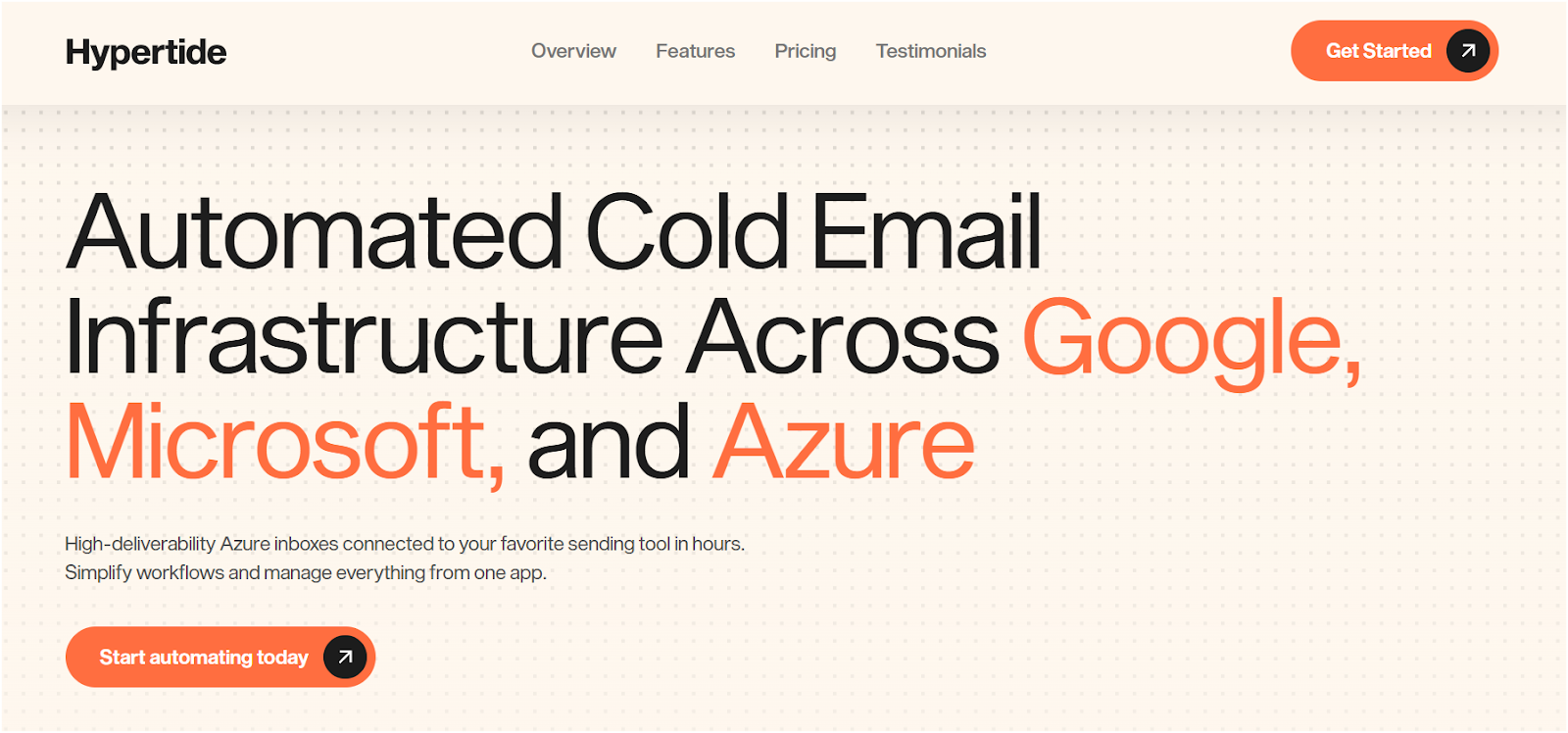
Hypertide is a cold outreach automation platform that helps B2B teams send personalized emails at scale without burning their domain.
Hypertide is designed for businesses seeking to scale cold emails efficiently, providing reliable infrastructure and high deliverability for outreach campaigns.
🚀 What Hypertide Says It Does:
- Helps you create and send cold email sequences
- Handles personalization, scheduling, and inbox rotation
- Protects your domain reputation with built-in warmup features
- Provides efficient campaign management for high-volume outreach
- Claims to be a “set-it-and-forget-it” engine for outbound
But does it actually do all that well? We’ll get to that.
For now, here’s who it’s really built for:
👤 Who Should (and Shouldn’t) Use Hypertide:
- ✅ Best for:
Founders, SDRs, and growth teams running cold outreach across multiple domains. Also ideal for lead generation agencies managing multiple client accounts, as it supports agencies handling several clients' outreach needs and simplifies account management for high-volume campaigns. - ❌ Not ideal for:
Teams looking for full CRM workflows or deep LinkedIn automation — it’s focused on email only
🥊 How It Positions Itself in 2025
Hypertide isn’t trying to be an all-in-one.
It’s not competing with HubSpot, Instantly, or Lemlist on feature bloat.
Instead, it leans hard on:
- Simplicity
- Deliverability
- Ease of setup across domains
Hypertide’s app provides a user-friendly interface that acts as a central hub for managing your email infrastructure. The app is designed to reduce technical complexity, making domain setup, DNS management, and inbox integrations straightforward for users.
It’s trying to be the “no-BS cold outreach tool” for people who don’t want to spend 3 hours figuring out DNS, sequences, and inbox warmup logic.
But positioning doesn’t always equal performance.
Keep reading to see what you actually get with Hypertide 👇
Hypertide Features: What You Actually Get
If you’re searching “Hypertide features” or trying to figure out what this tool actually does, here’s the breakdown without the marketing spin.
Hypertide isn’t a CRM. It’s not a sequencing tool.
Hypertide provides a user-friendly interface that lets you efficiently manage your outreach infrastructure, including inbox management and campaign tools.
Here’s what you actually get:
Automated Inbox Setup (4–6 Hours)
No VAs. No delays. Hypertide sets up inboxes across Google, Microsoft, and Azure automatically, in under 6 hours.
Hypertide deploys custom Azure inboxes for high-volume outreach campaigns, with each inbox hosted on its own Azure tenant to ensure tenant separation. This automated process guarantees inbox isolation and protects deliverability.
Pre-Configured DNS (SPF, DKIM, DMARC)
Hypertide manages all DNS records, including DMARC records, automatically—no need to touch your DNS panel. Every order comes with pre configured SPF for optimal deliverability, as well as correctly configured DKIM and DMARC out of the box.
Tenant Isolation (Not Shared)
Each setup is fully isolated, with separate domains, IPs, and accounts.
No shared sending pool. No one else can tank your domain reputation.
Plug & Play with Outreach Tools
Works with tools you already use:
✅ SmartLead
✅ Instantly
✅ Bison
Hypertide also integrates with major sequencers and offers API access for advanced automation and seamless integration with your existing email infrastructure.
You don’t need to change your sending strategy, just plug Hypertide into it.
50 Inboxes per Order (Scalable Sending)
One $50/month plan =
→ 50 inboxes per single order, designed to maximize reply rates
→ 5,000 emails/month sending capacity
→ All infrastructure handled
Bring Your Own Domains (Or Use Theirs)
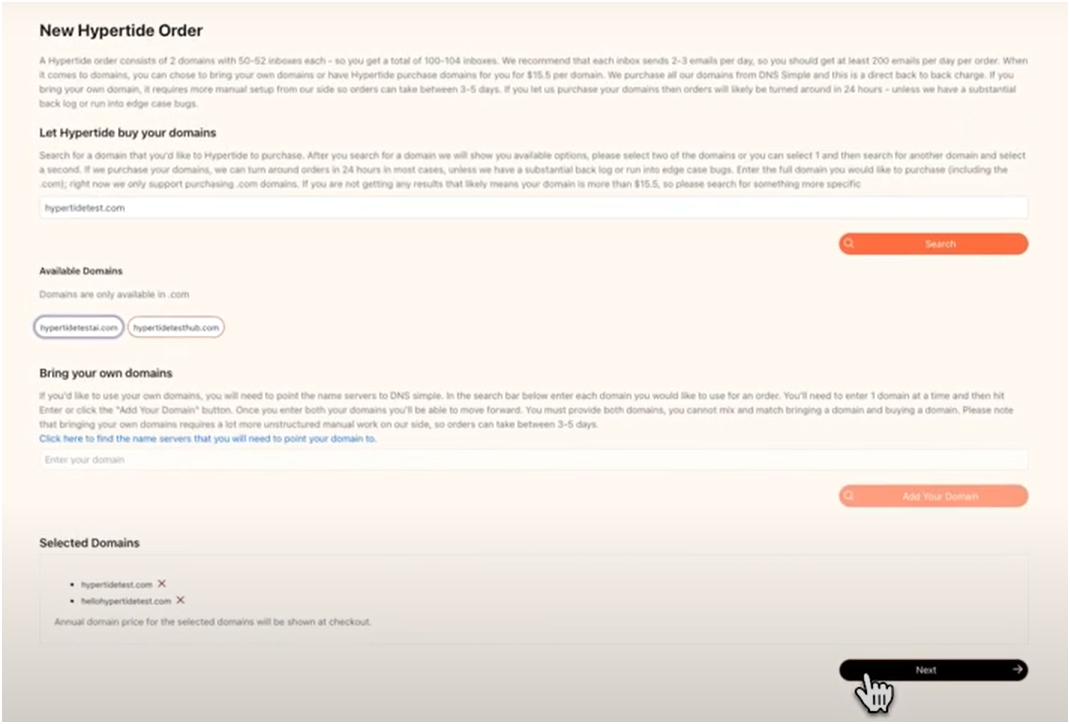
Already have domains? Use them.
Don’t? Buy new ones.
Hypertide handles either case with the same automation pipeline. You can choose to set up with just two domains for more flexibility and easier management. By automating technical setup, Hypertide allows your team to focus on list building instead of DNS configuration.
Warmup Tools Included
Access to internal warmup tools to manage inbox health at scale.
Built-in verification features help maintain sender reputation during the warmup process.
Control your warmup settings without jumping between platforms.
One Dashboard to Rule Them All
Manage all tenants, inboxes, and infrastructure in one place.
The dashboard streamlines inbox management and automates key processes for outbound campaigns.
No spreadsheets. No chaos. Just clean visibility.
Flat Pricing. No Surprises.
No tier upgrades. No add-ons.
$50/month per order. Simple. Predictable. Built for cold email scale.
Next up: let’s talk pricing of Hypertide.
Pricing Breakdown: What Hypertide Actually Costs in 2025
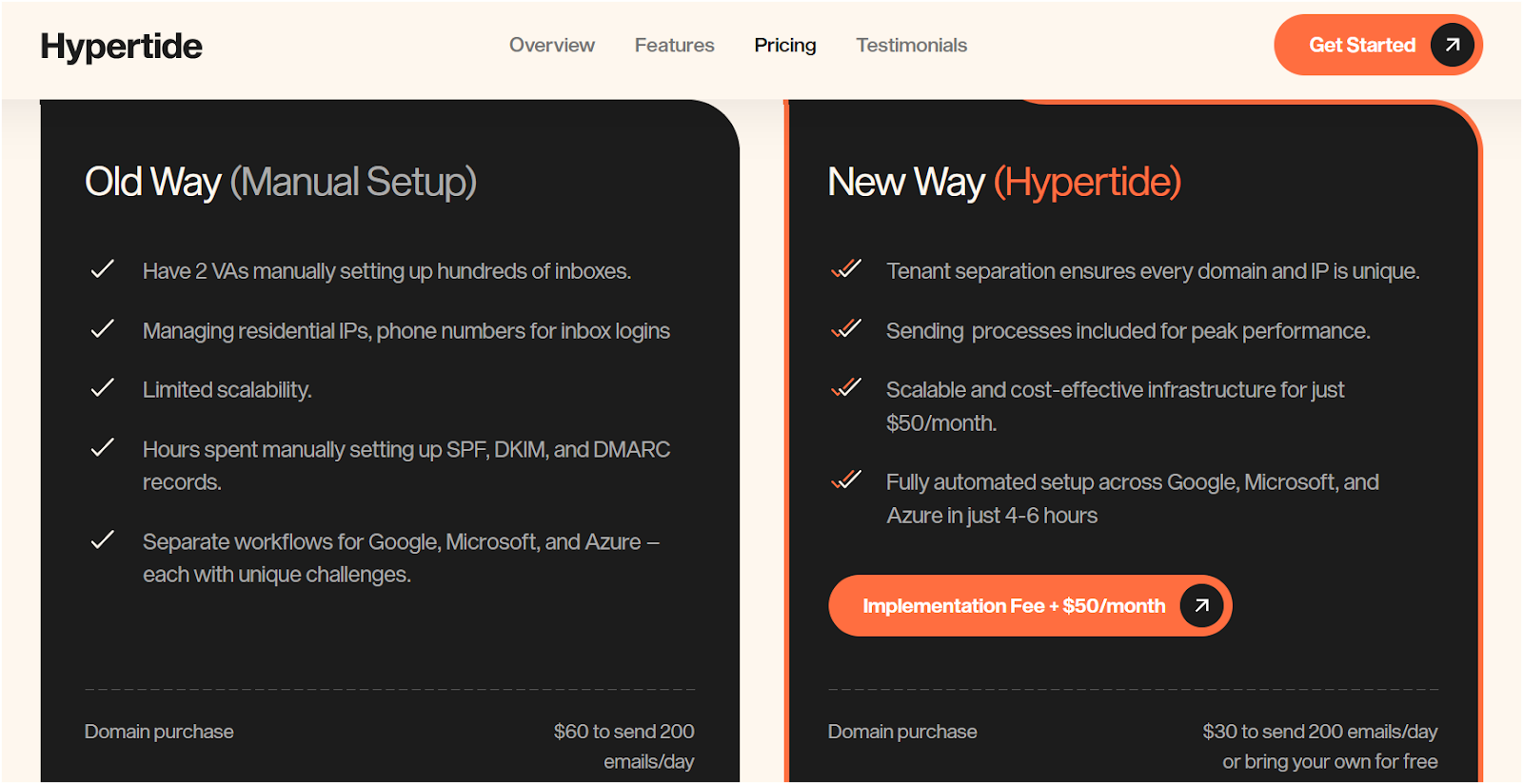
When you Google “Hypertide pricing,” here's what you usually don't see:
The full cost.
What's included?
And how it compares to other email infrastructure tools.
So here's the real breakdown, no marketing spin, just math.
Flat-Rate Pricing (No Tiers, No Guesswork)
Hypertide charges $50/month per order, plus a one-time setup fee.
Each order includes:
- ✅ 50 inboxes
- ✅ 5,000 emails/month sending volume
- ✅ Automated setup for Google, Microsoft & Azure
- ✅ Pre-configured DNS (SPF, DKIM, DMARC)
- ✅ Warmup tools and platform integrations
Agencies can easily manage billing for each client with predictable costs.
That’s it. No usage-based fees. No per-seat pricing. No “enterprise” surprise.
Hidden Costs (What You Should Know)
While the monthly cost is flat, here’s what may cost extra depending on how you set things up:
If you bring your own domains, that saves even more.
If you don’t, budget ~$30–$60/domain.
Next up: let’s talk pros and cons, where it wins, and where it doesn’t.
Hypertide Pros and Cons (Based on Real-World Use)
You’re probably not here to read a list of generic “pros” like
✅ Great UI
✅ Works as expected
You want to know if Hypertide is actually worth using in your workflow, or if it’s another cold email tool with a fancy landing page.
One of Hypertide’s key strengths is its focus on protecting sender reputation and ensuring high deliverability for your cold outreach campaigns.
So we broke it down honestly, what Hypertide does well and where it falls short, based on reviews, user feedback, and hands-on testing.
Use this to decide if it’s the right fit or a waste of time.
Pros of Using Hypertide
Cons of Using Hypertide
Hypertide works if you know what you’re doing and need a scale.
It won’t hold your hand. But if your team is solid and you need automated infrastructure, it delivers.
Next, let’s look at the best Hypertide alternative, just in case it’s not the one for you.
Best Hypertide Alternative (If It’s Not For You)
Hypertide isn't for everyone.
Suppose you're looking for more control, faster support, or a platform that handles not just inbox infrastructure but also DNS, warmup, and inbox placement monitoring.
In that case, you'll probably want something more flexible.
That’s where Mailforge steps in.
Mailforge – The Best Hypertide Alternative for Cold Email Infrastructure
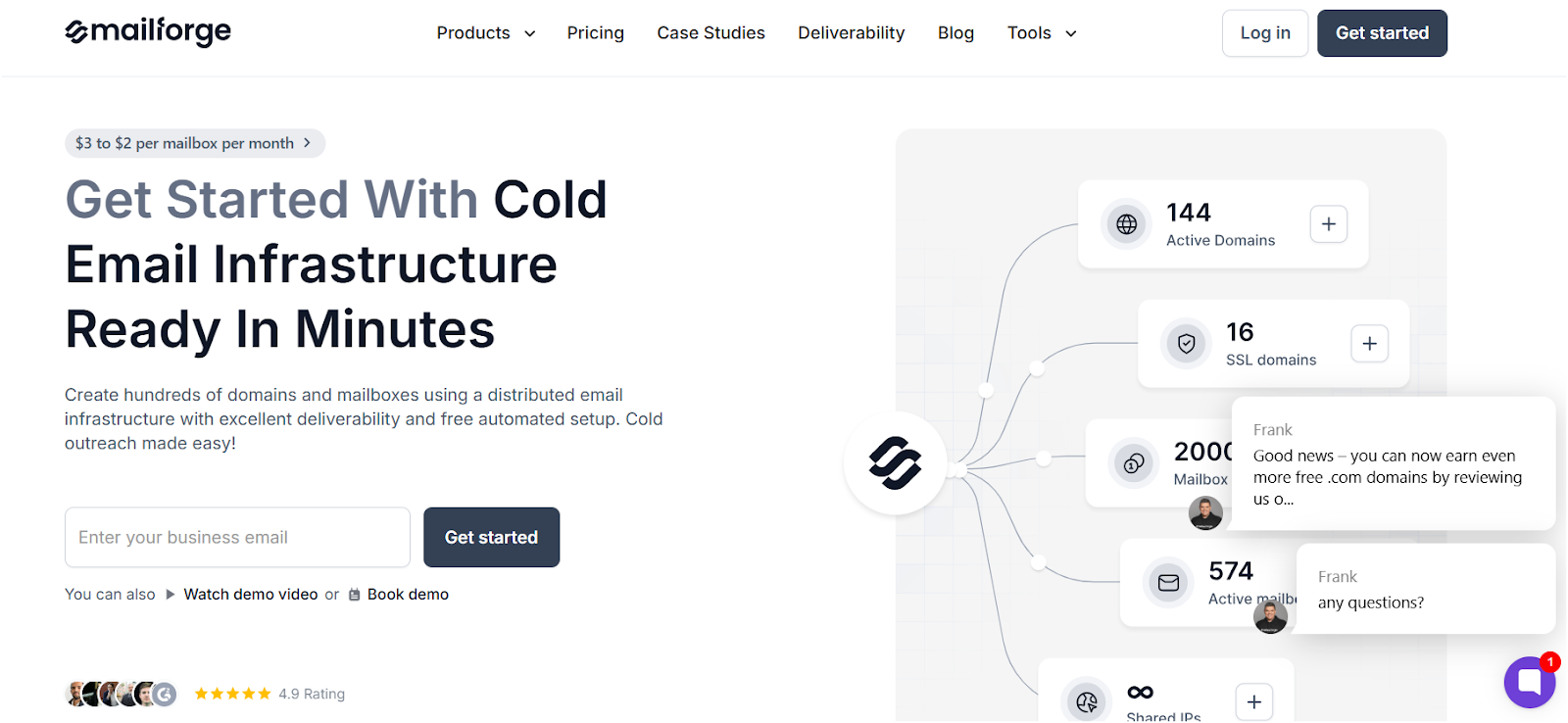
If Hypertide gives you speed and bulk inbox creation, Mailforge gives you control and clarity.
Where Hypertide is a black box with automation, Mailforge is built for ops teams, founders, and agencies who want infrastructure visibility, not just setup speed.
Here's what makes it different:
What Mailforge Does Better Than Hypertide
When to Choose Mailforge Over Hypertide:
Use Mailforge if you:
- Need real-time visibility into DNS health and domain reputation
- Want to customize warmup rules and not rely on default logic
- Run multiple brands and want a dashboard that doesn't just “set and forget”
- Prefer to own your infrastructure stack rather than plug into a shared backend
In short, Mailforge is the better pick if you're serious about email deliverability and long-term infrastructure control.
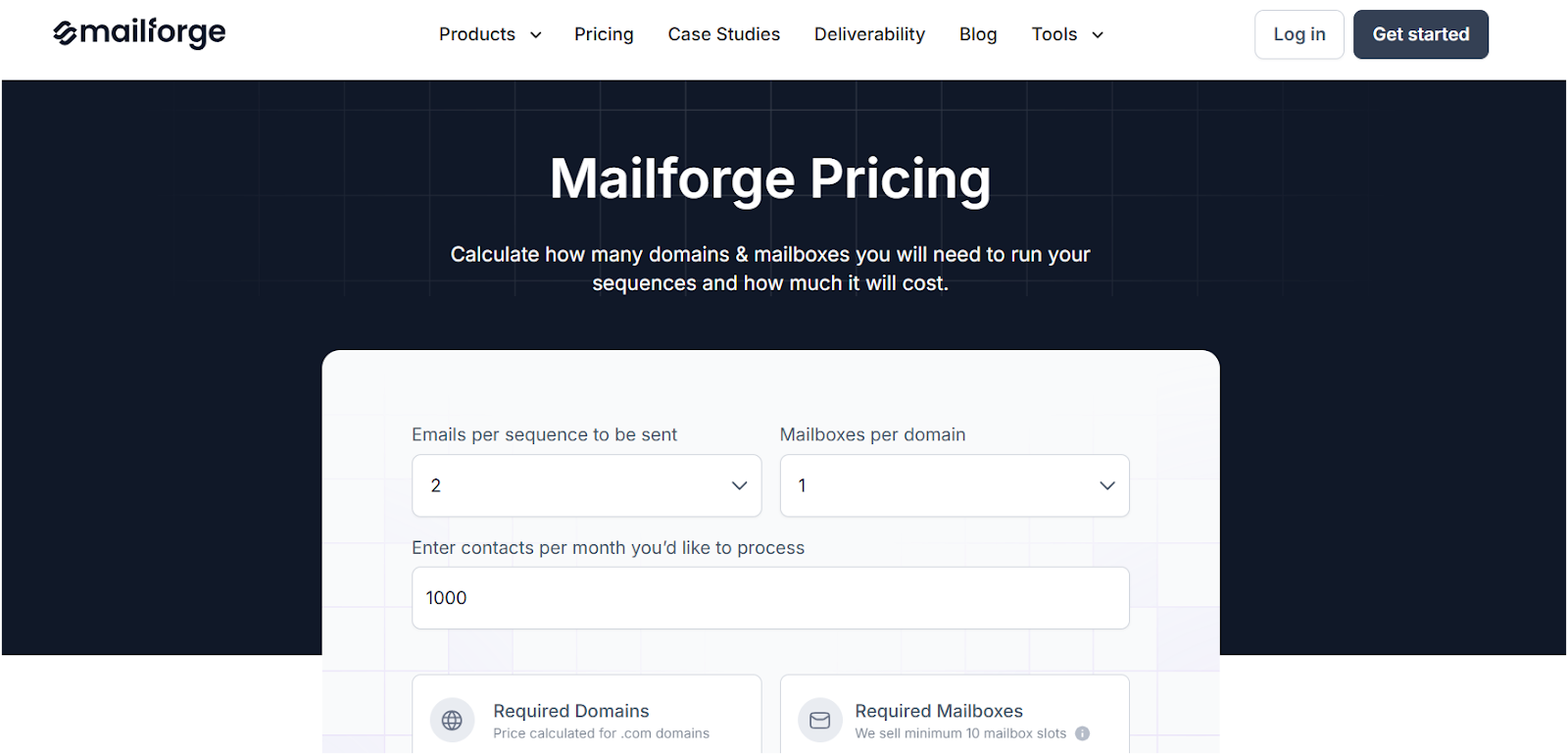
Final Verdict: Is Hypertide Worth It in 2025?
Hypertide is a solid choice, but only if you're playing the cold email game at scale and know exactly what you're doing.
If you're an agency, ops lead, or founder managing multiple domains and inboxes, Hypertide gives you the speed and infrastructure to get up and running fast, no VAs, no manual setup, no DNS headaches.
But it's not built for everyone.
There's no real-time monitoring. No sequencing. No trial. And minimal support if things go wrong.
If you want more control, better visibility, and hands-on tools to protect your email reputation, is a better Hypertide alternative
Mailforge helps you with:
- DNS & domain health dashboards
- Daily inbox placement monitoring
- Custom warmup logic
- Faster, human support
- And a clean UI built for scale
➡️ Try Mailforge now — before you burn another domain.